I often see discussions on social media about the benefits (or not) of thwacking yarns as part of the ‘finishing’ process. People seem to be quick to condemn, with the idea that it is a terrible way to treat a yarn, or only done to compensate for a ‘badly spun’ yarn. I wanted to bust this myth 🙂 So for Issue 19 of tinyStudio magazine I researched and wrote an article, this was published in May 2023. Felt that since this such a recurring discussion on our social media pages, it was worth publishing it also on the blog as well! So here is my article including my conclusions about the value of thwacking!
This is a question that comes up from time to time in online fiber groups. Someone asks ‘what is this thwacking I’ve heard about, and why would you do that to your yarn?”
They are referring to the practice of hitting, or ‘thwacking,’ a skein of damp yarn against a hard surface during the finishing process. What follows this relatively innocent question are usually helpful answers that almost always include; for, against, and ‘depends.’ Occasionally there are some (rather judgey) comments about how you should spin ‘properly’ for balance so you never need to beat your yarn. Answers can also go to the other extreme of; ‘always’ thwack to even twist and finish correctly.
I think most spinners will sit somewhere in the middle, with the ‘depends’ answer. Here is why ‘I’ think this is a useful response.
I will begin with a story from my own early spinning lessons with someone I consider to be a very knowledgeable ‘old school’ teacher. Mary taught us to thwack our yarns. It was just simply the way it was done! We spun mostly carded roving with a short forward draw to make semi-worsted yarns. No one suggested it should be beaten to within an inch of its life or done with excess force or malice, but just thwacked enough to set the twist. I don’t recall much discussion about balanced yarns, although that was always what we were aiming to spin.
How to Thwack
Yarn thwacking is a simple process. The skein should be damp, just out of its nice warm bath, given a dip into cold water, and then the excess water pressed out with a towel. The yarn should be well-saturated but not dripping. I recommend four ties around the skein. Make sure the knots are well tied, as you don’t want to lose a tie as you thwack and end up with a tangle!
Take one end of the skein, then swing it around and down against your chosen hard surface. I always found the edge of the bath to be convenient, or the doorframe (outside). I guess the process is called ‘thwacking’ because of the very specific sound this damp skein makes when it hits the surface! There is no other way to describe it.
I would typically give it a couple of thwacks, then move my hand along the skein and do it again until I have worked my way around the entire skein. However, I wouldn’t normally do more than four or five thwacks on most fibers. You will soon get a feel for this, but in general, it is always better to ‘under thwack’ than to do it too much because you can thwack more, but you can’t remove them once you have done them.
Having learned to finish all my yarns this way, I continued to thwack all my yarns until the day I also started to wonder why. I tried not thwacking.. most likely, this was with one of my (at the time) standard skeins of semi-worsted yarns spun from carded roving or mixed fibers, and I was happy with the results. I also tried not thwacking my more worsted yarns spun from Merino top. I liked how the yarns were smooth and even, and the non-thwacked versions were great; I felt no need to return to thwacking! I now applied this ‘new’ concept to all my yarns and continued to set the twist in the same way, less the thwack. Sometimes I would snap the skein a few times just to get any kinks out or hold one end of the skein and spin it around a few times to get out more water.
Then one day, I wanted to spin some woolen yarns using a long draw technique. The plan was to make a blanket, and I specifically wanted to spin a lovely lofty fluffy yarn for it. I had some carded Corriedale and spun it into nice, softly squishy bobbin fulls. I loved the airy look when these yarns were plied, and when they went into the hot water, I could also see they were going to bloom nicely. For this yarn, I had done some research; I had read about thwacking yarns made with angora or mohair fibers in order to bring out the halo and enhance their character by doing so. Also, that thwacking was good for bringing out the loft in woolen yarns. I decided to apply this theory.
From this point on, I have thwacked yarns that I wanted to be fluffy and lofty and are made from carded fibers (although I don’t thwack any art yarns), and I have not thwacked my worsted yarns, allowing them to remain smooth and compact. But, if it is true that thwacking is only useful for ‘badly’ spun yarns and shouldn’t really be done at all, am I wasting my time thwacking my woolen yarns too? Let’s find out!
Why Thwack?
So why would thwacking make a difference to a yarn, and what kind of fibers and preparations are suitable for thwacking? We can use some general ideas about this which we can take as a guide to start investigating.
My understanding is that a carded fiber preparation contains fibers of different lengths, running in different directions, which allows lots of air to get trapped between the fibers for a lofty yarn. When a new yarn is wetted and thwacked, this process brings back any crimp or curl that might have been lost in the preparation and spinning process, creating more air space inside the yarn, and consequently more loft.
This will occur even when you simply saturate the yarn in hot water, the scales will open up, and the fibers will revert to their original crimp. Thwacking allows the fibers to bloom even more by aiding in opening them up and pushing the air into the yarn, creating more space for the fibers to bloom.
A worsted yarn is smoothed as it is spun from a combed prep in which the fibers run parallel, leaving less room for air or loft, resulting in a smoother yarn. Thwacking will add loft and fluff up even a worsted yarn, although this might not be the effect you want in this kind of yarn.
Method
For the purpose of this ‘Mythbusting’ series, it was time to make some samples and experiment!
For this experiment, I chose some Gotland and Polwarth locks, all washed and dyed by me with the same method and dyes. I used my Majacraft hand cards to process the Polwarth (oh so soft!) into gentle rolags and then the Gotland the same way. I also decided to do a 50/50 blend of both fibers just for fun. I chose to only experiment with woolen spun yarns (carded fiber spun long-draw) rather than both woolen and worsted, because I am already quite content in my early discovery that thwacking worsted spun yarns encourages more bloom (and consequent fluff) than I wanted in those yarns. So my focus here is on finding out if there is any advantage to thwacking woolen spun yarns – maybe I will save myself the time and effort of doing so!
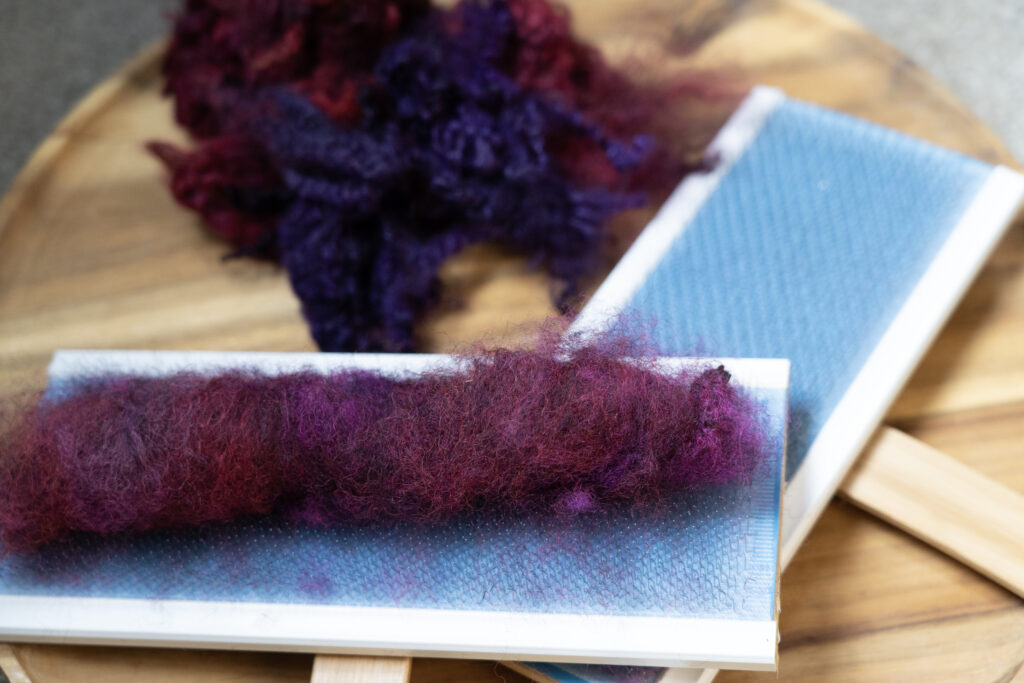
I spun my rolags into separate singles, and then plied them on themselves from a plying bracelet into two-ply yarns. This gave me one sample of each of the Polwarth, the Gotland, and the 50/50 blend. I wrapped each one around a book, splitting the yarn into two sections of roughly half each, then cut the yarn between the sections to make two yarns from each sample.
I then soaked all my samples in warm water for ten minutes, transferred them into cold water, and finished by pressing the excess water out in a towel.
With my two fiber types, it was easy to see which was which because the fibers were very different, I chose them because I thought it would be interesting to see if there was much observable difference between the fine wool and the long wool samples when thwacked. A variable in my experiment was that not all fibers react the same way to specific treatments, so the additional question was; ‘does thwacking effect all woolen spun yarns the same way no matter what fiber is used?’
I hung one of each of the pairs to dry, and thwacked the second sample of each pair on the edge of the hand basin I had washed them in. I thwacked each yarn separately, counting eight thwacks so they received the same treatment across all three samples.
I hung these to dry, too and then waited impatiently for the breeze to do its job.
I think the combination of water, movement, and the summer breeze, combined into a powerful magic and transformed the yarns!
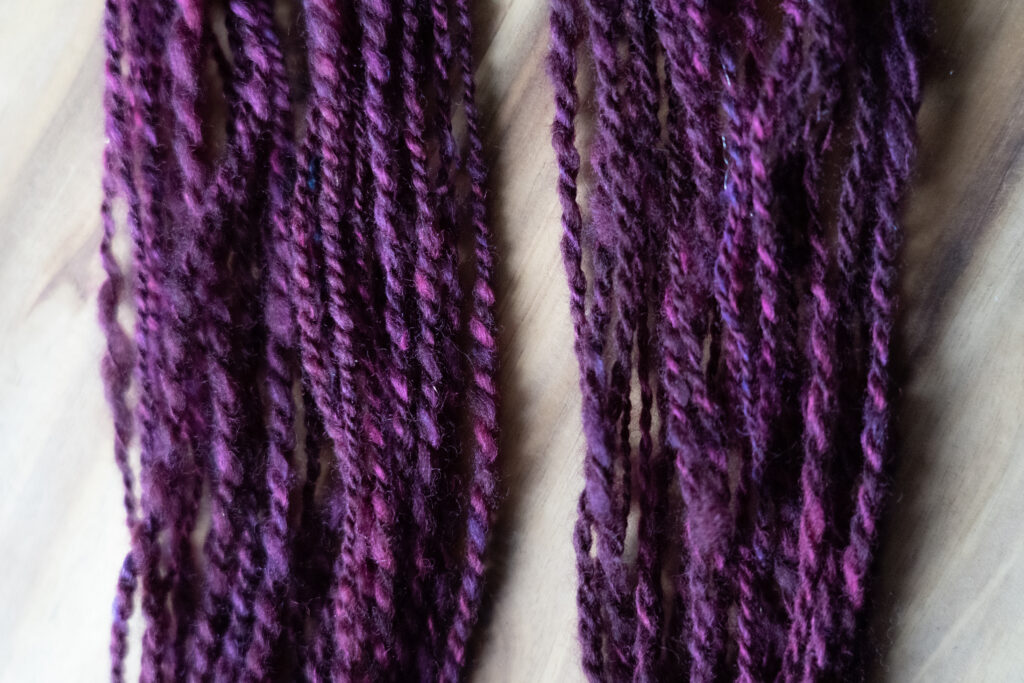
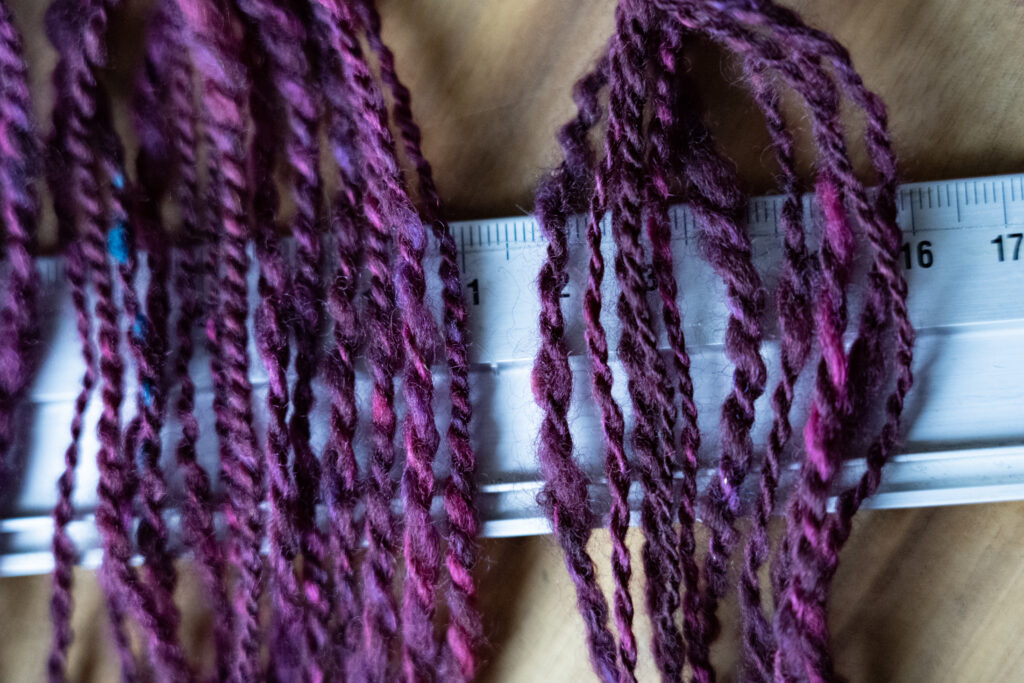
Results
The overall feel and handle of the woolen spun yarns improved with thwacking. The thwacked yarns feel softer, possibly because the sharper ends of the individual fibers sticking out have been softened or blended better into the yarn. This was most noticeable in the 100% Gotland sample, which felt much softer and loftier when thwacked. Unexpectedly, the least noticeable difference in handle and feel was in the Polwarth/Gotland blend, which did show blooming in the thwacked skein, but not nearly as much difference in the feel of the finished yarn.
The 100% Polwarth bloomed more than the Gotland, with the thickness and softness more clearly enhanced between thwacked and non-thwacked samples. This will be from the extra crimp in the Polwarth, compared to the Gotland, so you can expect more blooming and puffy fluffiness with a crimper fiber than you will get with curly long wool.
In all the samples, the difference between thwacked and not thwacked was fairly obvious in both look and feel. The thwacked samples were bulkier and had bloomed more than the non-thwacked yarns. The best way I can describe it is that the fuzziness turned to fluffiness. Also, the twist was definitely more evened out, and the thwacked yarns just felt more ‘finished’ compared to the non-thwacked. Remember, all these samples were woolen yarns, soaked and wet, finished in the same way and in the same water (temperature). The ones that were not thwacked are perfectly nice, but I definitely prefer the look and feel of the puffed-out, softer, thwacked yarns.
In the end, the only real conclusion I can draw, is – use whatever method you enjoy and that gives you the yarn you want! It is perfectly fine for us to all have our own preferences 🙂
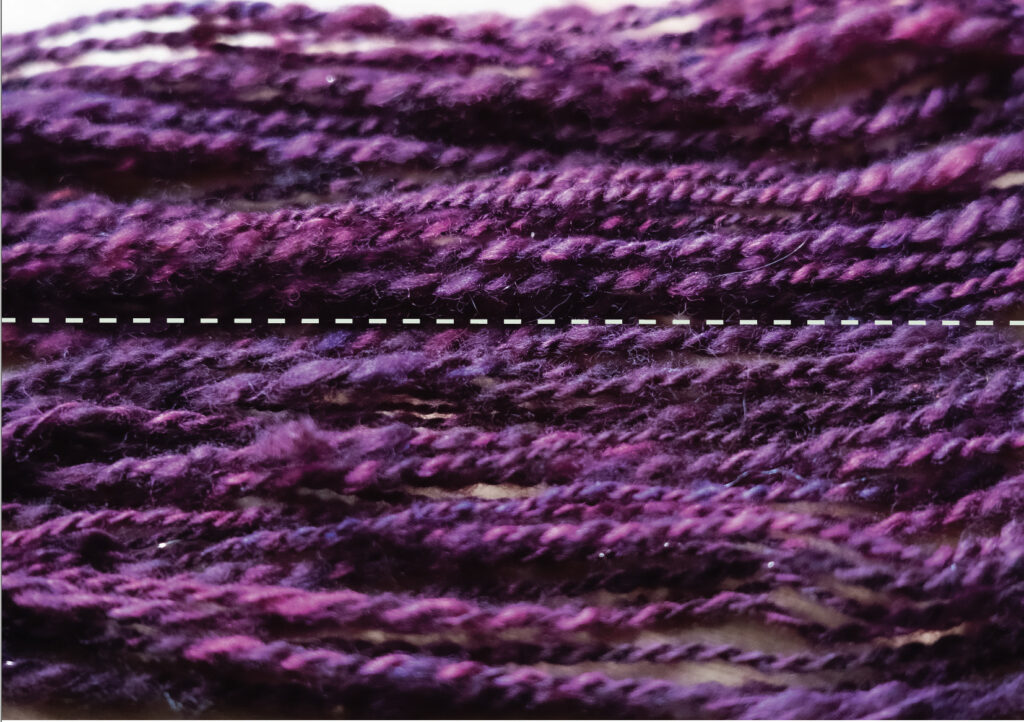
Above: Another view of the Polwarth samples, the top half is thwacked and the yarn on the bottom half of the image is not thwacked.
Further research
To follow this experiment, it would also be interesting to do this same process but with worsted spun yarns too; what happens to the smooth compactness of a worsted yarn when it is thwacked compared to non-thwacked, and then compared to woolen thwacked yarns as well. And what about semi-worsted yarns too (carded fiber spun with a worsted forward draw). On the basis of this woolen spun experiment we could anticipate a good degree of bloom from the carded fiber, but how much influence does the drafting and smoothing have on the yarn?
It might also be of interest to use two different colors in the plies, so a white single plied with a black single, for example, in order to better assess how much the twist changes with thwacking and see more clearly how well it is evened out (if at all).
Overall, I think this myth is not exactly busted but also not exactly proven! It remains a case of ‘it depends,’ – but I can say; don’t let anyone tell you that thwacking is only good for badly spun yarns!
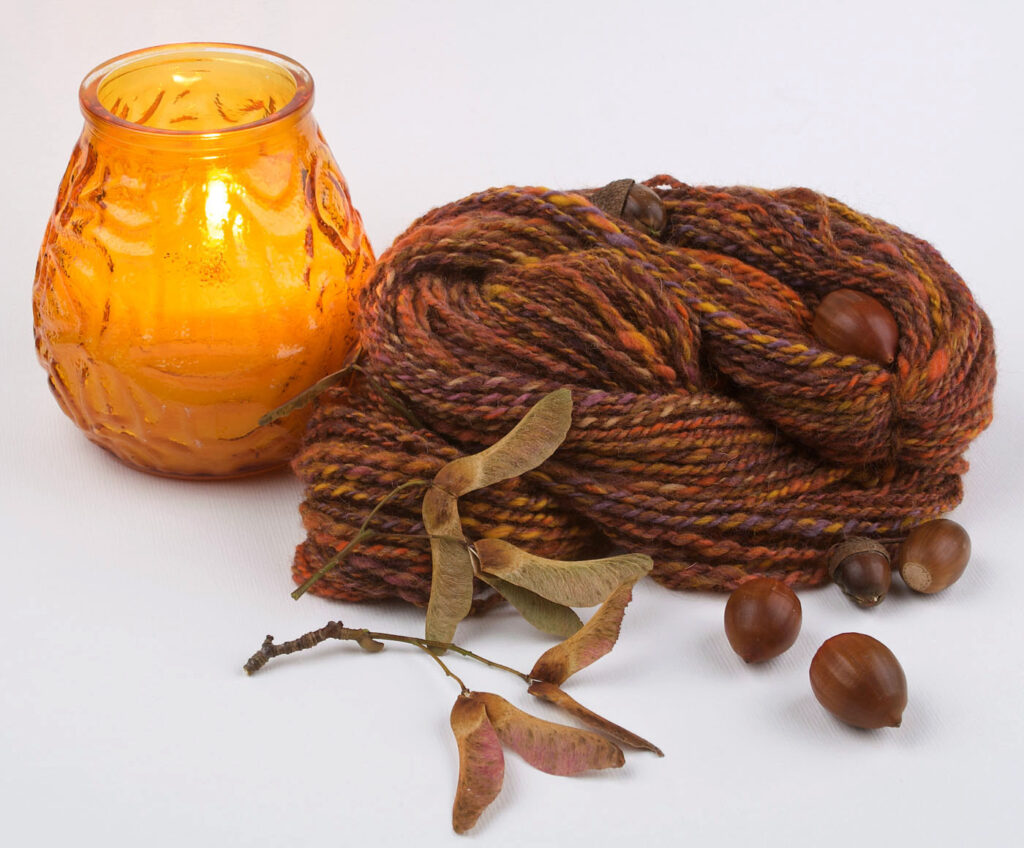
You have convinced a non thwacker. Thank you Suzie.
I say try anything once! And then you will know if it works for you or not. I was certainly pleased with the improved handle 🙂
I am a fan of thwacked woollen yarn, but I do a sort-of ‘reverse thwack’ for my worsted yarn.
I take the damp skein, and put my arms through the loop, with the skein resting just above my wrists. I then jerk my arms apart firmly, rotate the skein, then repeat – about the same number of times as you do with thwacking.
It doesn’t make the yarn bloom, but it does help the plies snug evenly against each other; and no one has ever accused me of uneven plying 🙂
So long as you aren’t beating yourself up 😀 Sounds interesting!
Thank you for this content. The issue of thwacking has been on my mind for sometime. I enjoyed reading this outloud to my husband as we discussed “to thwack or not to thwack”.